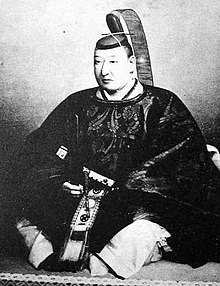Abe Masahiro
| Abe Masahiro | |
|---|---|

Abe Masahiro
|
|
| Lord of Fukuyama | |
|
In office January 31, 1837 – August 6, 1857 |
|
| Preceded by | Abe Masayasu |
| Succeeded by | Abe Masanori |
| Personal details | |
| Born |
December 3, 1819 Edo, Japan |
| Died | August 6, 1857 (aged 37) Edo, Japan |
| Nationality | Japanese |
| Spouse(s) | Matsudaira Noriko, a daughter of Matsudaira Haruyoshi |
Abe Masahiro (阿部 正弘?, December 3, 1819 – August 6, 1857) was the chief senior councillor (rōjū) in the Tokugawa shogunate of Bakumatsu period Japan at the time of the arrival of Commodore Matthew Perry on his mission to open Japan to the outside world. Abe was instrumental in the eventual signing of the Convention of Kanagawa in 1854, and other unequal treaties shortly afterwards. His courtesy title was Ise-no-kami.
Abe Masahiro was born in his family's residence outside Edo Castle. He was the 5th son of Abe Masakiyo, the 5th daimyō of Fukuyama Domain. Upon his father's death in 1826, his elder brother Masayasu became daimyō of Fukuyama; Abe was moved to the domain's naka-yashiki ("middle residence") in Hongō, Edo (modern-day Bunkyō, Tokyo). However, in 1836, Masayasu adopted his brother as heir. Abe became clan leader and daimyō of Fukuyama upon his brother's retirement in on December 25, 1836.
In early 1837, he left Edo and made the long journey to Fukuyama to formally enter his domain. This would be the only time that Abe set foot in his domain, as his career as a bureaucrat within the Tokugawa shogunate eclipsed his obligations to return to Fukuyama under the sankin-kōtai system.
Abe was appointed to the post of sōshaban (master of ceremony) on September 1, 1838; on May 15, 1840, he received the post of jisha-bugyō (Magistrate of shrines and temples). One of his acts was to order the destruction of the Nichiren sect temple of Kannō-ji, whose priests had become involved in a scandal with ladies of the Ōoku under Shogun Tokugawa Ienari.
...
Wikipedia
